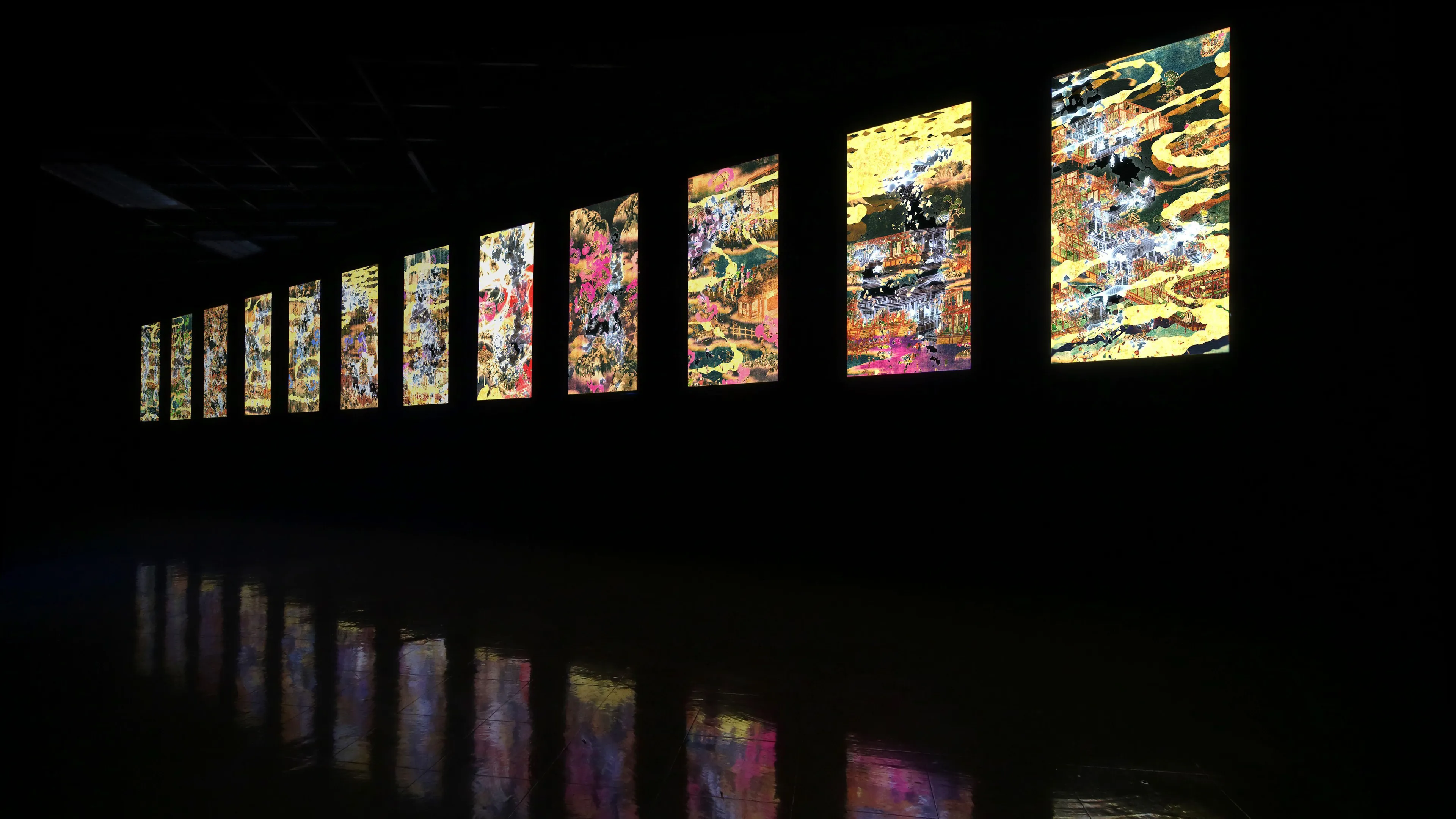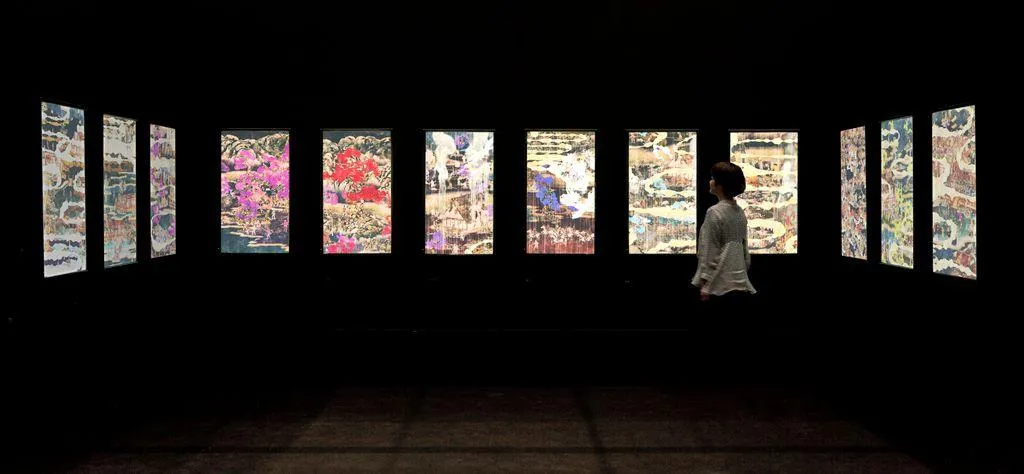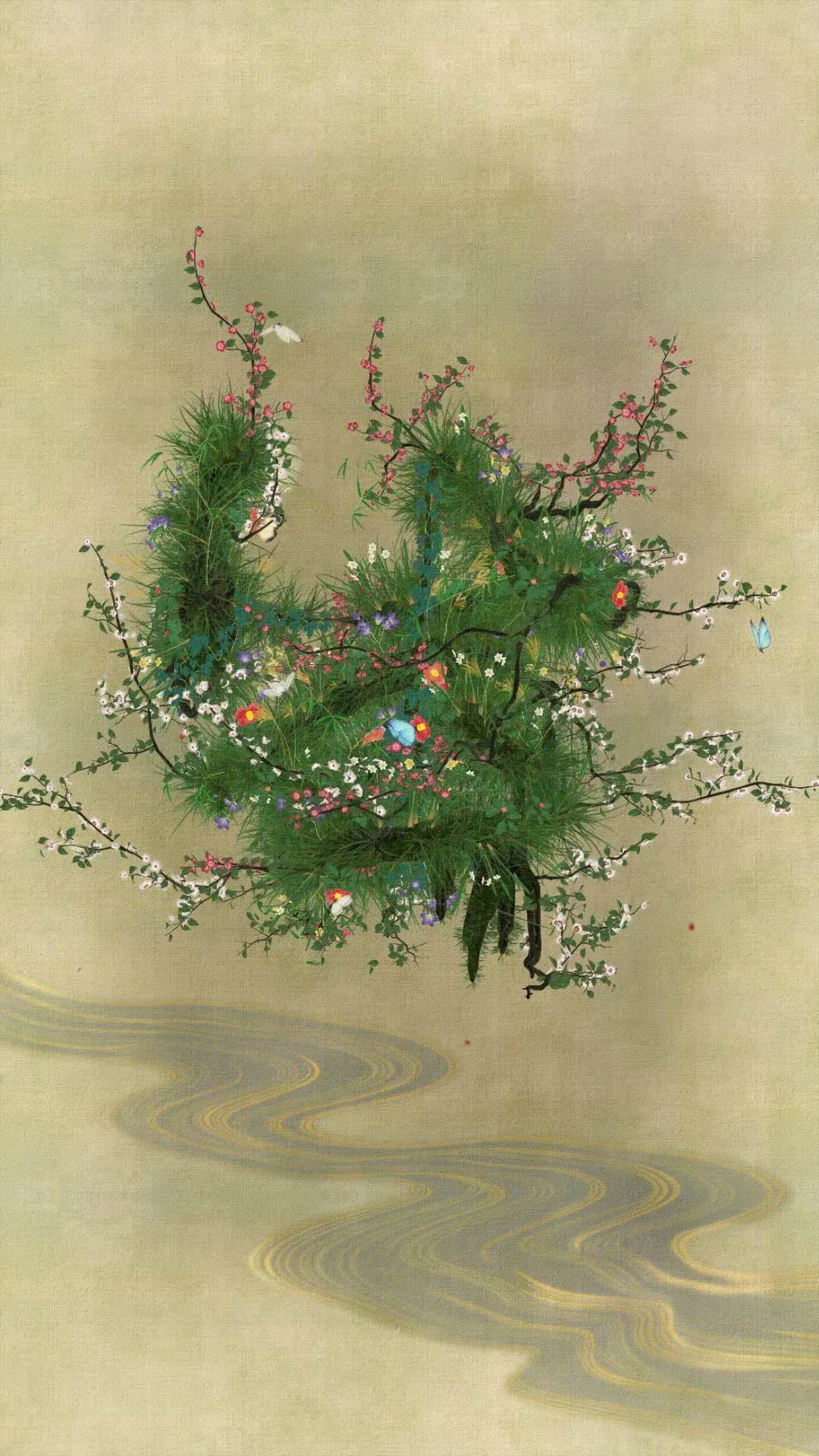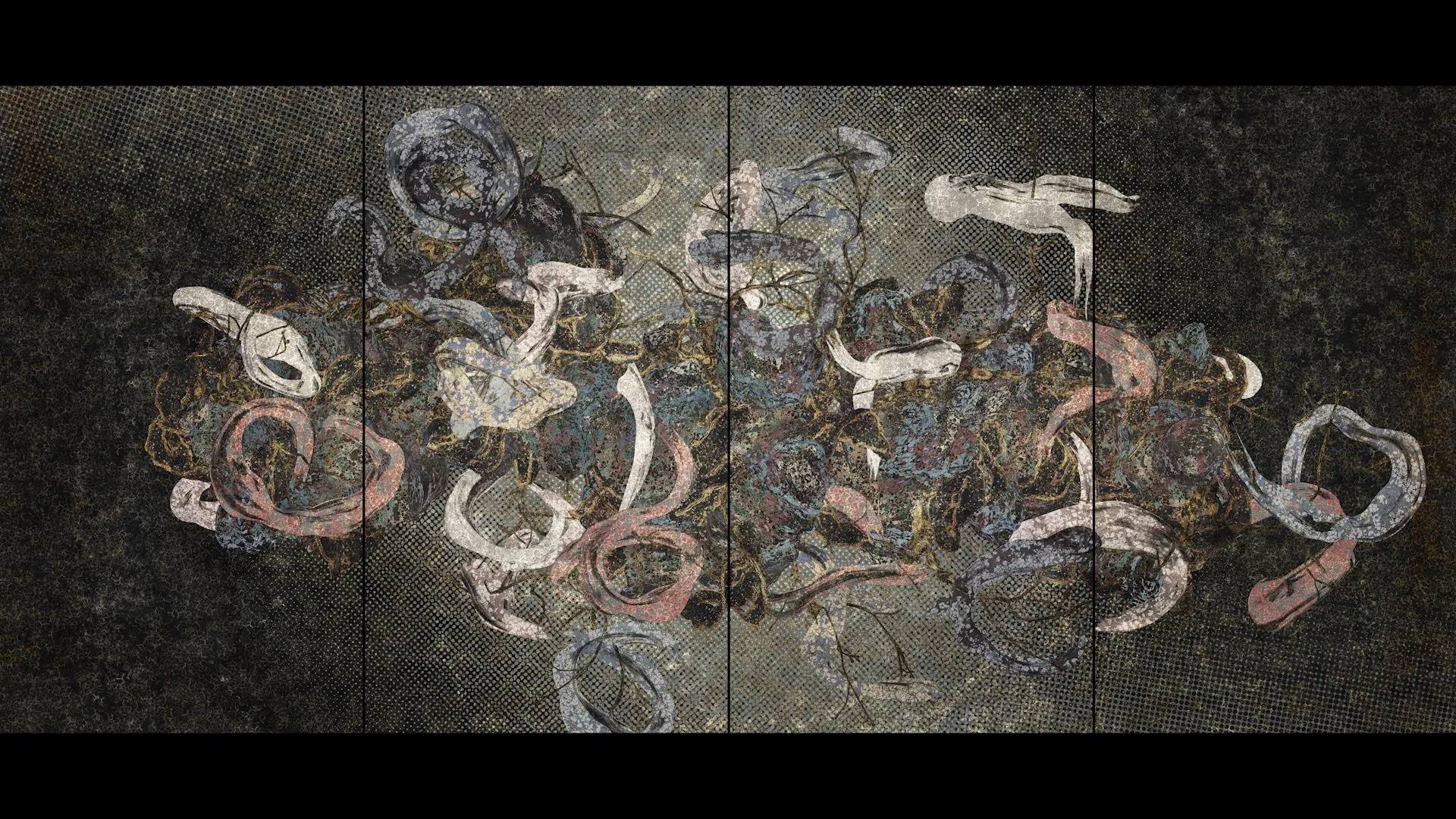A Flattened Space that Dissolves the Boundary between the Physical World and the World of the Artwork
Lenses and Perspective Create a Boundary between the Artwork Space and the Body of the Viewer
When three-dimensional space is made two-dimensional by lenses or Western perspective, such as in paintings, photographs, and videos, the picture plane becomes a boundary, and the artwork space appears to exist on the other side of the picture plane. A boundary is created that divides the space where the viewer is physically located and the space of the artwork that is cut out and framed by the lens or perspective.
Ultrasubjective Space Does Not Form a Border and is Continuous with the Space Where the Viewer’s Body is Situated
Premodern East Asian paintings are said to be conceptual or planar, but teamLab believes that these paintings construct two-dimensional space using a different logical structure from those created by lenses or Western perspective. Furthermore, the surface of a two-dimensional image created using this logical structure does not create a border between the space where the viewer’s body is situated and the world of the painting (the artwork space).
teamLab explored this logical spatial structure using new digital methods. Specifically, we created the artwork space in three dimensions on a computer, then looked for a logical structure that converted it into two dimensions, such that it looked like the picture space of a premodern East Asian painting. In other words, we looked for a logical construct that could render the space in two dimensions without creating a boundary between the world in which the viewer’s body is located and the space represented by the surface of the artwork.
We called this logical construct “ultrasubjective space.” The surface created by ultrasubjective space does not become a boundary, and it is continuous with the space in which the viewer’s body is present. Furthermore, we discovered that with ultrasubjective space, we can freely move the viewpoint, the plane does not have a center, and it can be folded, divided, or joined, unlike a space rendered in two dimensions by Western perspective.
Ultrasubjective Space Frees and Centers the Viewer’s Body
In ultrasubjective space, the viewpoint can be moved. With space created by a lens or perspective, the viewer's body is fixed. But with ultrasubjective space, the viewer regains the freedom to move their body. The viewer can comprehend the world through their body as they move. In ultrasubjective space, there is no center, and the space can be divided, which means that the viewer can look at the entire picture plane and see the full space of the work, or they can look at only a part of the plane and see only that part of the artwork space. This means that multiple viewers can freely view the same plane of the work from different positions, centering themselves, and enter a part of the artwork space. Additionally, the ability to join planes created using ultrasubjective space means that the boundaries between works can be eliminated: different artwork spaces can join together on a single plane, and new artwork spaces can be created. The fact that ultrasubjective space can be folded gives freedom to adapt and change the exhibition space of the artworks (Fig. 1 and 2).
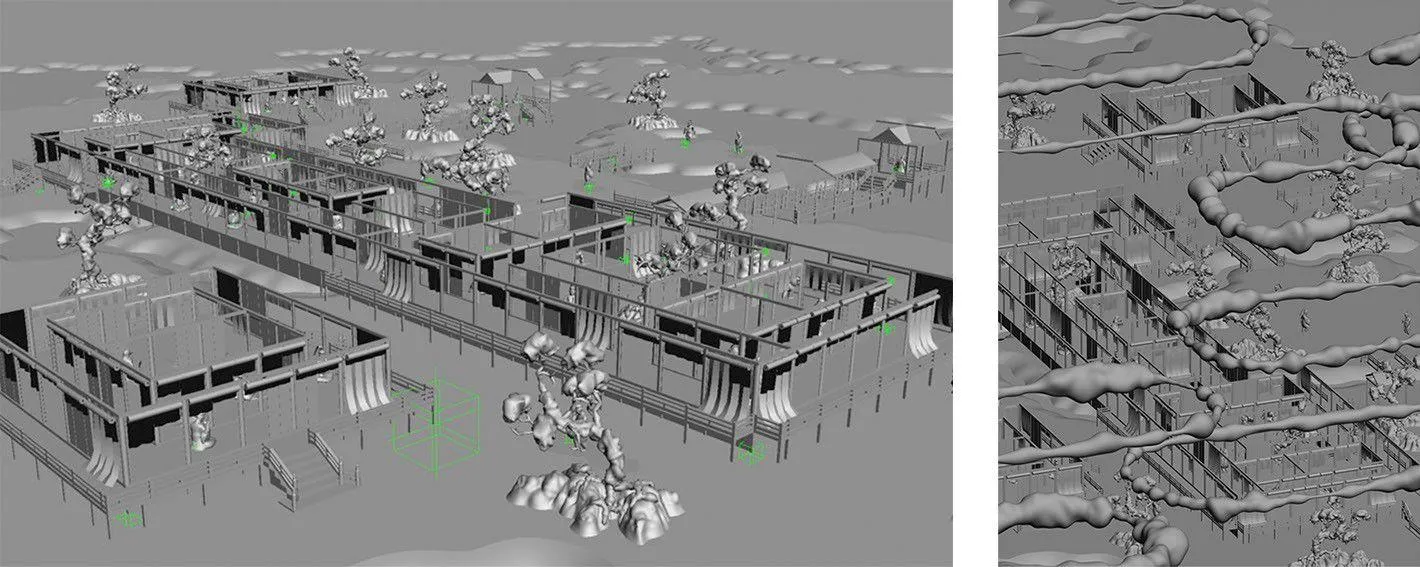
[Figure 1]
(left): A three dimensional space flattened using Western perspective (from the artwork Flower and Corpse Glitch Set of 12).
[Figure 2]
(right): The same three-dimensional space as in Figure 1, but flattened using the logical structure of ultrasubjective space (from the artwork Flower and Corpse Glitch Set of 12)
Mov. 1:Finished painting (from “Flower and Corpse Animation Diorama”)
Seeing the World as in a Premodern East Asian Painting
A simplified version of a photograph taken through a lens, or an image drawn in Western perspective (Fig. 3) is a fan-shaped space spanning out from the photographer or painter’s viewpoint (blue person in Fig. 4), and that space is made two-dimensional (Fig. 4). The viewer is then seeing the world from the perspective of the painter.
Now, assuming that people were able to see the world as in the premodern paintings of East Asia (Fig. 5), and assuming that the painter is the blue person in Fig. 6, the light blue part of Fig. 6 would become visible.
You may think that it is impossible to see the world in this way, but the range of what the physical eye can see at any given moment is extremely narrow, and the focus is shallower than you think it to be.
So why do we think we can see more than we can in reality?
Humans have a time axis, and we can move our eyeballs, thereby moving the focus of our eyes. The brain synthesizes the many images obtained through this narrow and shallow focus in order to perceive the space. In other words, it could be said that we see space by logically reconstructing sets of narrow, shallow, two-dimensional images of parts of the space going back to some time in the past. The space that we perceive with our bodies is a reconstruction of a set of parts that are much larger than the parts that we perceive when we capture the whole space with a lens. And it is in such sequences that the notion of time is contained.
Today, humans constantly see the world as it is captured and framed by lenses, such as in photographs and movies, so they may not find the plane rendered in two dimensions through a lens awkward. However, humans move their heads and move about in space. Although the amount of time may increase to synthesize and reconstruct the image, if we think that we synthesize it in our brains using a logical structure different from that of lenses and perspective, it would not be surprising that we perceive the world as shown in Fig. 6.

[Figure 3]
Mona Lisa
© RMN-Grand Palais (Musée du Louvre) / Michel Urtado / distributed by AMF-DNPartcom
[ Figure 4 ]
[ Figure 5 ]
Honensho picture scroll
[ Figure 6 ]
Enter into the Picture While Viewing It
If you (Fig. 7, blue human figure) look at a person captured in a perspective picture or photo (Fig. 7, red human figure), you will see the world of the artwork as something separated from you, as though you are looking through a window (Fig. 7, light blue area). Likewise, the person in the artwork would see the real physical space where you are as an external viewer (Fig. 7, pink area).
But if you and the person in the painting saw the world as shown in Fig. 8, as the world is shown in premodern East Asian paintings, the character in the artwork (Fig. 9, red human figure) would see the pink area in Fig. 9. While you (Fig. 9, blue human figure) would see the light blue area. In other words, the character inside the painting perceives almost the same landscape as you, a person outside of the painting (Fig. 9, overlapping pink and light blue areas). You would continue to view the landscape in the painting even if you stepped into the painted character's shoes. While viewing the painting you can enter and move around freely within the world of the artwork. The viewer does not hold a dominant perspective over the depicted space, and they are instead merged into the experience.

[ Figure 7 ]
[ Figure 8 ]
[ Figure 9 ]
Suppose you take a series of photos of an object up close with a camera, and then stitch these images together to form a whole picture (Fig. 10). The result will differ completely from a single photograph of the whole object taken at a distance (Fig. 11). In Western linear perspective or through a lens, a composition of multiple planes in which the object space is partially captured from a close series of points (Fig. 10), cannot be the same as a wide shot in which the object is captured as a whole in two dimensions (Fig. 11).
In the case of ultrasubjective space, a plane composed of multiple detailed planes (Fig. 12) is logically the same as a plane depicting the entire space (Fig. 13). The plane consisting of combined parts of the space — each shown in detail — is equivalent to the plane where the entire space is depicted.
This means that viewer centricity is possible. When you view a painting from a position where it can be seen in its entirety, you can imagine yourself inside the space represented in the painting. Step closer to the painting so that you can see only one part of it, and you visually enter only that part of the space represented in the painting (Fig. 12). You can see the picture freely from anywhere. There is no limit to the viewpoint, which can move (Fig. 13).
Traditional Japanese picture scrolls, emaki, and screen paintings, fusuma, are created with this in mind. Scroll paintings are placed on a table and their separate scenes are viewed by unrolling the scroll with the left hand. You look, in other words, at the individual parts of a larger whole. Fusuma screen paintings are also painted with the understanding that the individual screens will slide and can be moved.

[Figure 10]
A plane that is pieced together from smaller planes, with each representing a part of the space in perspective
[Figure 11]
A plane that recognizes the entire space in perspective
[Figure 12]
A plane that is pieced together from multiple, finely detailed planes that each represent a part of the space in ultrasubjective space
[Figure 13]
A plane that recognizes the entire space in ultrasubjective space
A plane of ultrasubjective space can be freely divided, and seeing a divided part of a picture means being in a space that the portion represents. Since a picture plane of ultrasubjective space can be divided in this way, it can also be folded. While it is impossible to fold or divide a photograph or a perspective painting. Fusuma sliding door panels are a canvas that is able to be divided, and byobu screens are a canvas that is designed to be folded.
The fact that the plane in which the parts of a space that have been made two-dimensional in ultrasubjective space are, when joined together, equivalent to the plane of the entire space, means that the planes of ultrasubjective space can be freely joined together. This means that different artwork spaces can be unified on one picture plane, and a new artwork space can be created without spatial discrepancy. Separate, individual artwork spaces can together become a new, borderless artwork space.
No Boundary between Viewer and World in Ultrasubjective Space
The way people see the world has a great impact on the way they behave towards the world.
Since people today are constantly looking at the world as cut out by lenses, such as in photographs and videos, they see the world as though looking through a lens. In doing so, their body and the space they are looking at become completely separated, creating a clear boundary. This causes people to feel as if they are able to exist independently of the world.
However, If we see the world through ultrasubjective space, the boundary between the body and the world disappears, and the two existences become a single, seamless entity. It enables us to recognize ourselves and the world as a borderless continuity.
